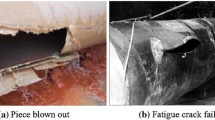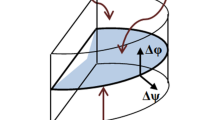Abstract
Stress intensity factor (SIF) of surface cracks (semi-circular, semi-elliptical, and irregular shapes) located on a circular pipe (hollow) has been determined using numerical method. The irregular-shaped crack geometry was considered in the present work in order to simulate the cracks that are generally developed during service condition. The interaction behavior of multiple cracks on SIF calculation has also been investigated. Crack aspect ratios [a/c; “a” is the crack depth and where “c” is semi-major axis of elliptical crack] ranging between 0.6 and 1.0 and crack depth ratios [(a/d); where “d” diameter of the pipe] ranging between 0.1 and 0.4 were considered. Irregular-shaped cracks were modeled by keeping the crack depth (a) constant. For a regular profile semi-elliptic crack [(a/c) = 0.6], higher SIF was observed at crack middle region [(S/S0) = 0]. In contrast, higher SIF was observed at crack surface region [(S/S0) = ± 1] for semi-circular crack. Asymmetric spreading of SIF was noticed because of added effect of mode-II and mode-III fracture. In addition, the leading mode of fracture at short crack depth [(a/d) ≤ 0.1] was mode-II (in-plane shear) and mode-III (out of plane shear) fractures whereas at deep crack depths [(a/d) ≥ 0.4], the leading mode of fracture was mode-I fracture which is crack opening mode. Marginal influence of crack aspect ratio was noticed at crack surface region [(S/S0) = ± 1] and the effect is significant at crack middle region [(S/S0) = 0]. For a constant crack depth, higher SIF was obtained at the middle region [(S/S0) = 0] compared to regular profile crack. When comparing the observations of regular semi-elliptic crack, higher influence of mode-II and mode-III fracture was observed for irregular-shaped semi-circular crack which may leads to additional crack growth. Thus, approximating the standard crack geometry may over/under predict the SIF values. It is also inferred that the presence of adjacent cracks significantly affects the SIF of middle crack due to interaction effect. The interaction behavior was observed to be more pronounced when multiple cracks are located at closer interval. The interaction effect reduces gradually when the distance between crack centers increases. The improved SIF solutions obtained with consideration of additional fracture modes will be useful during the residual life determination.




















Similar content being viewed by others
Abbreviations
- a :
-
Semi-major axis length (mm)
- c :
-
Semi-minor axis length (mm)
- d :
-
Thickness of pipe (mm)
- a/c :
-
Crack aspect ratio
- (a/d):
-
Crack depth ratio
- S, S0 :
-
Points along the crack front
- σ :
-
Far field stress (MPa)
- K :
-
Stress intensity factor
- Y :
-
Correction factor
- ν :
-
Poisson’s ratio
- p :
-
Fluid pressure (MPa)
References
R.J. Hansler, J.M. Ham, G.M.H. Laheij, Analysis of failure causes of pipelines transporting dangerous substances, in Proceedings of the 6th Pipeline Technology Conference (2011)
C.H. Achebe, U.C. Nneke, O.E. Anisiji, Analysis of oil pipeline failures in the oil and gas industries in the Niger Delta Area of Nigeria, in Proceedings of the International Multi Conference of Engineers and Computer Scientists 2012, Volume II (2012)
P. Rajeev, J. Kodikara, D. Robert, P. Zeman, B. Rajani, Factors contributing to large diameter water pipe failure as evident from failure inspection, in Conference Proceedings (2014)
Masayuki Kamaya, Influence of the interaction on stress intensity factor of semielliptical surface cracks. J. Press. Vessel Technol. 130, 11406-1 (2008)
Masayuki Kamaya, Crack growth under high-cycle thermal fatigue loading: effects of stress gradient and relaxation in a crack network. J. Press. Vessel Technol. 133, 061203-1 (2011)
Masayuki Kamaya, Growth evaluation of multiple interacting surface cracks Part I: experiments and simulation of coalesced crack. Eng. Fract. Mech. 75, 1336–1349 (2008)
Shinji Konosu, Kyosuke Kasahara, Multiple fatigue crack growth prediction using stress intensity factor solutions modified by empirical interaction factors. J. Press. Vessel Technol. 134, 011404-1 (2012)
J.M. Alegre, I.I. Cuesta, Stress intensity factor equations for internal semi-elliptical cracks in pressurized cylinders. J. Press. Vessel Technol. 133, 054501-1 (2011)
A.A. Ali, J. Purbolaksono, A. Khinani, A.Z. Rashid, F. Tarlochan, Evaluation on an internal surface crack in a compound tube. J. Press. Vessel Technol. 131, 064501-1 (2009)
A. Kiciak, G. Glinka, D.J. Burns, Calculation of stress intensity factors and crack opening displacements for cracks subjected to complex stress fields. J. Press. Vessel Technol. 125, 260–266 (2003)
D. Renowicz, M. Ciesla, Crack initiation in steel parts working in boilers and steam pipelines. J. Achiev. Mater. Manuf. Eng. 21(2), 49–52 (2007)
Mario S.G. Chiodo, Claudio Ruggieri, Failure assessments of corroded pipelines with axial defects using stress-based criteria: numerical studies and verification analyses. Int. J. Press. Vessels Pip. 86, 164–176 (2009)
Fernando Dotta, Claudio Ruggieri, Structural integrity assessments of high pressure pipelines with axial flaws using a micromechanics model. Int. J. Press. Vessels Pip. 81, 761–770 (2004)
Sebastian Cravero, Claudio Ruggieri, Structural integrity analysis of axially cracked pipelines using conventional and constraint-modified failure assessment diagrams. Int. J. Press. Vessel Pip. 83, 607–617 (2006)
I.V. Orynyak, S.M. Ageev, Calculation of reference stresses for circumferential irregular-shaped defects in pipes. Int. J. Strength Mater. 43, 1–15 (2011)
S. Suresh Kumar, M. Murugan, S. Kalimuthu, N. Balaji, Mixed mode stress intensity factor determination of multiple cracks in hollow circular pipe. Int. J. Fail. Anal. Prev. 16, 555–561 (2016)
Acknowledgment
Funding for this work was supported by the management of SSN College of Engineering, Chennai, India.
Author information
Authors and Affiliations
Corresponding author
Additional information
Publisher's Note
Springer Nature remains neutral with regard to jurisdictional claims in published maps and institutional affiliations.
Rights and permissions
About this article
Cite this article
Suresh Kumar, S., Naren Balaji, V. Mode-I, Mode-II, and Mode-III Stress Intensity Factor Estimation of Regular- and Irregular-Shaped Surface Cracks in Circular Pipes. J Fail. Anal. and Preven. 20, 853–867 (2020). https://doi.org/10.1007/s11668-020-00888-9
Received:
Published:
Issue Date:
DOI: https://doi.org/10.1007/s11668-020-00888-9




